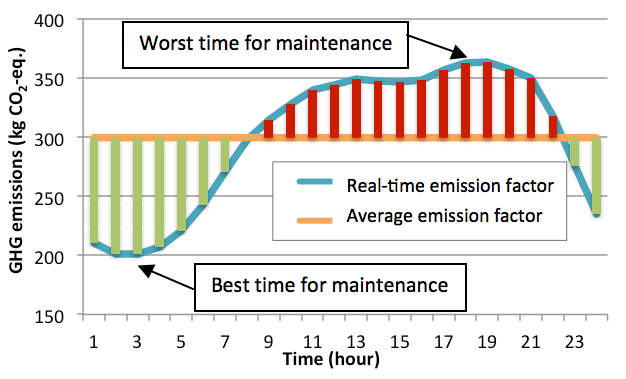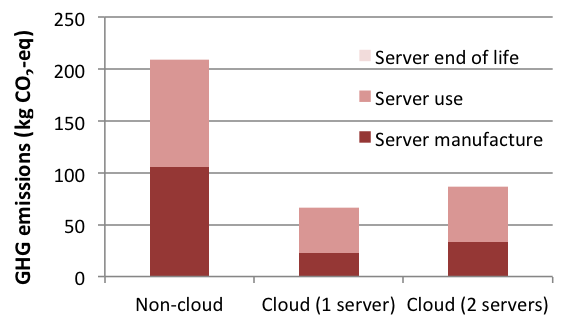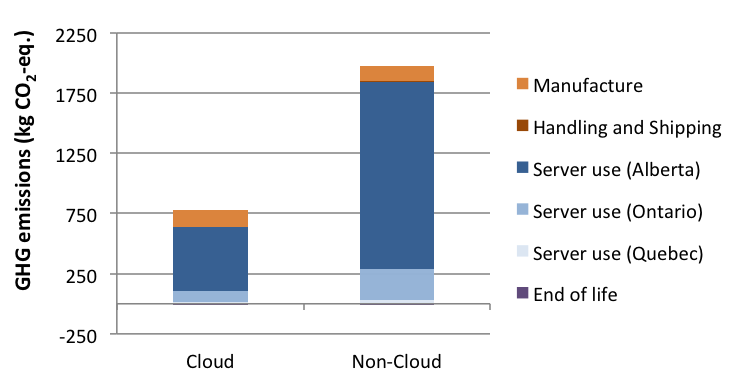The Green Sustainable Telco Cloud (GSTC) is a project lead by Professor Mohamed Cheriet of University of Quebec’s École de technologie supérieure (Canada), supported by Ericsson, Canada’s NSERC and the Prompt consortium (www.promptinc.org) through the Equation initiative (www.equationict.com) and made in collaboration with University of Toronto and Polytechnique Montréal. In this project, an innovative Telco-grade cloud technology has been developed to minimize cloud computing impacts on the environment (cf. http://www.synchromedia.ca/node/870 for more details). To evaluate the environmental benefits of the GSTC technology, several applications were investigated using the life cycle assessment (LCA) method. The main advantages of the LCA are:
- to consider the entire life cycle of the GSTC: including natural resources extraction, manufacture, handling and shipping, use phase and the end of life;
- to take into account several environmental indicators, not only CO2 or green house gas (GHG) emissions, providing a broader environmental picture of the GSTC technology.
1. Real-time emissions factors
While LCA is adapted to evaluate static products like plastic or glass bottles, the methodological framework is not suitable to study dynamic systems such as the GSTC (carbon footprint methods using average emissions factors suffers from the same weakness). To overcome that issue, historic and real-time data were introduced in LCA to represent temporal variations in electricity generation and related emissions. As a first application, the real-time emissions factors were used to compute a GSTC 'green factor' and 'truly' minimize GSTC emissions in the context of a server maintenance activity (Figure 1).

Figure 1: GHG emissions of a server maintenance activity
2. Cloudification benefits for a videoconference service
The GSTC technology was evaluated using the green factor in the context of a videoconference service. At the server level, life cycle impacts attributed to the videoconference service are significantly reduced when the GSTC technology is used (cf. Figure 2). This benefit is due to better energy efficiency and a lowered hardware requirement when implemented in the multi-tenant GSTC.

Figure 2: Server life cycle GHG emissions of a videoconference service
Moreover, the use of a second server to improve the quality of the videoconference service does not significantly increase the environmental impacts when compared to a single server solution making the use of a second server suitable from quality of service and environmental perspectives.
3. Environmental advantage of GSTC servers offloading
An LCA was conducted to analyse the environmental benefits of the GSTC technology used to offload servers' load. Based on the green factor, 2 modern central data centres offloading 10 edge data centres emit fewer GHG emissions than 19 edge data centres (cf. Figure 3). While the server GHG emissions are reduced by 30%, the life cycle GHG emissions are only reduced by 6% due to the additional data traffic generated by offloading.

Figure 3: Server life cycle GHG emissions with and without server offloading
4.GSTC Emissions saving at the Canadian scale
LCA was used to evaluate the environmental benefits of deploying the GSTC at the Canadian scale. For an IMS service, the cloudification of the servers enables significant reduction in emissions during the use phase when compared to a non-cloud context (cf Figure 4). The more the electricity mix is based on fossil fuels, the more the green factor is optimized by the GSTC technology.

Figure 4: GHG emissions saved by a Canadian GSTC
5. Server-load balancing to minimize carbon footprint
A new method of consequential LCA was developed to compute marginal emissions factors of electricity generation on the short term (marginal emissions correspond to sources of electricity affected by a sudden change in the power demand). Application of this method to the context of real-time server-load balancing along a data centre network spread in several regions makes it possible to minimize GHG emissions in comparison to the situation of a single data centre (cf. Table 1).
Table 1: Comparison of data centres GHG emissions with and without server-load balancing optimization

It should be pointed out that a server-load balancing optimization based on marginal emissions factors is expected to be more accurate than an optimization based on average emissions factors since it better reflects the electric grid behavior.
Conclusion
In all these cases, LCA was successfully applied to evaluate GSTC environmental performance in various contexts. All results support the conclusion that the GSTC enables reduction in environmental impact of the servers in comparison to situations where no cloud technology is deployed. LCA results may be used to evaluate GSTC activities over a given period but also to monitor it in real-time. Moreover, LCA results can be implemented with an optimization algorithm to represent environmental constraints.

